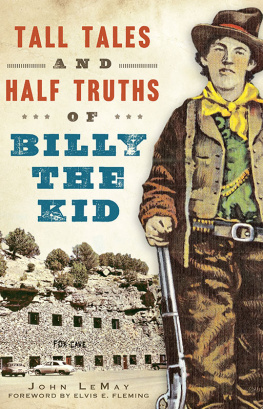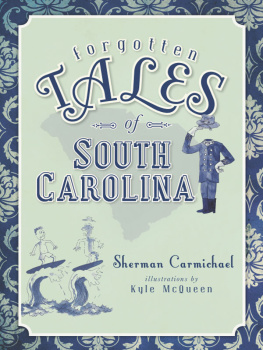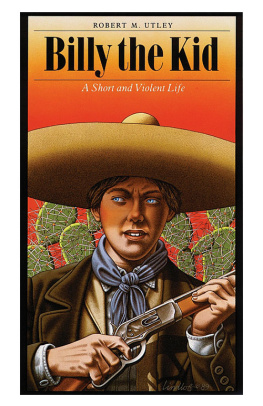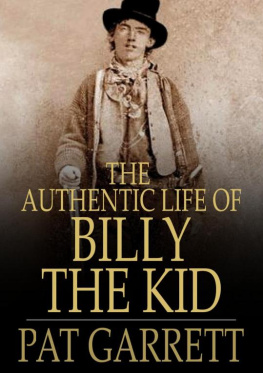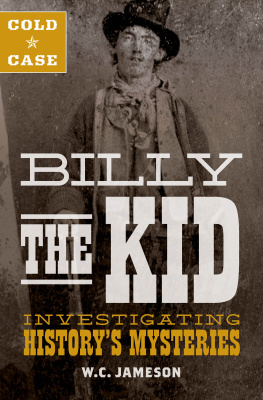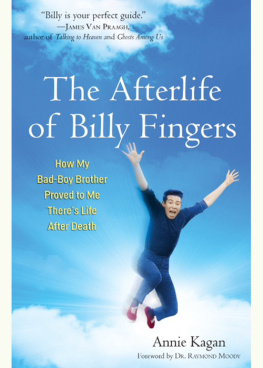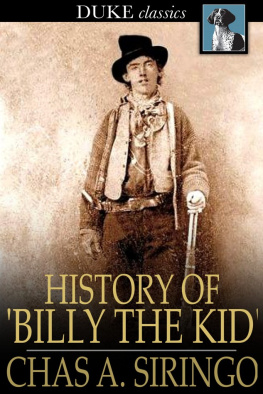

Published by The History Press
Charleston, SC 29403
www.historypress.net
Copyright 2015 by John LeMay
All rights reserved
Cover photographs courtesy the Historical Society of Southern New Mexico.
First published 2015
e-book edition 2015
ISBN 978.1.62585.511.4
Library of Congress Control Number: 2015934857
print edition ISBN 978.1.62619.996.5
Notice: The information in this book is true and complete to the best of our knowledge. It is offered without guarantee on the part of the author or The History Press. The author and The History Press disclaim all liability in connection with the use of this book.
All rights reserved. No part of this book may be reproduced or transmitted in any form whatsoever without prior written permission from the publisher except in the case of brief quotations embodied in critical articles and reviews.
For the wolf pack, with whom I have roved the wilds of Lincoln and the skyscrapers of Seattle.
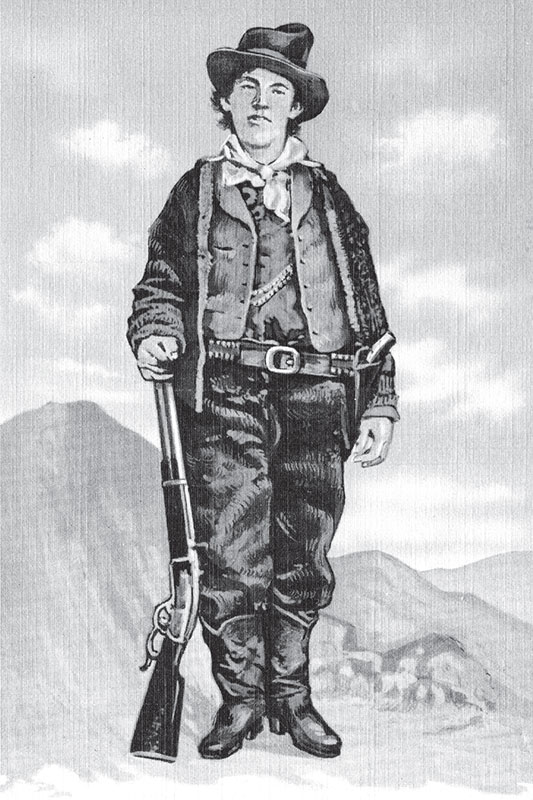
The Kids famous tintype as a colorful postcard sold to tourists in the 1940s. Historical Society for Southeast New Mexico, #914.
CONTENTS
FOREWORD
One approaches the task of writing another book about Billy the Kid, or another book about the Lincoln County War, with much fear and trembling. Most of us who have written on the subjects did so only after many years of study and contemplation, and we decided at length that perhaps we had something to add to the story. Hence, there seems to be no end to the myriad books on what are arguably New Mexicos most famous historical event and its most notorious denizen.
Probably most of the literature pertaining to Billy the Kid is of dubious veracity to some extent or other. Those stories did not have to be true to be useful in this study, as the emphasis is Tall Tales and Half Truths of Billy the Kid. John LeMay has done a yeomans job of ferreting out every imaginable sourcescholarly works, popular books, pulp magazines, newspaper articles, folklore and old-timers accounts on the Kid and the context of his careerto compile a narrative that seeks the truth about said stories. There is no other book like this one. If a story surfaces that is illogical, weird or obviously not true, no problem. John has taken those stories and researched them to determine whether there is a grain of truth or not. He gives his opinion of the origin, the truthfulness or lack thereof and the importance of the stories. And in those cases where the truth is elusive, he uses his vast knowledge of the situation and his grasp of the context to extrapolate conclusions about what likely happened or what was unlikely to have happened.
The end product of John LeMays work is a useful and quite readable book on Billy the Kid that contains many details about his life and adventures, as well as those of his doppelgangers after Billy was gone. All in all, it makes for a very entertaining read, and the author is to be commended for the effort it took to compile this book. While the text identifies Johns sources, complete with reference notes, at the same time the narrative is written in a rather informal and at times even humorous vein.
Anyone who wants to develop a broader understanding of Billy the Kid should have this book. It is apparent that some aspects of Billys life and career will never be known for sure and certain. In this day and age in which Billy the Kid is a major generator of tourist dollars for New Mexico, do we really want to know the whole truth, and nothing but the truth?
ELVIS E. FLEMING
Professor Emeritus, Eastern New Mexico University
Former Chief Archivist, Historical Society for Southeast New Mexico
Author of Captain Joseph C. Lea: From Confederate Guerrilla to New Mexico Patriarch
Roswell, New Mexico
ACKNOWLEDGEMENTS
First off, Id like to thank Bonnie Montgomery of the Historical Foundation for Southeast New Mexico for connecting me to The History Press and also all the researchers and archivists who helped me with the text and to gather photographs. Among them are Elvis Fleming; Lynda Sanchez; Tom Carey; Larry Knadle; Tina Williams; Amy Davis; Jared Olive; Morgan Nelson; Frederick Nolan; Earl Pittman; Gary Cozzens; Angel Mayes; William Cox II; Jacquelyn Reese and Sara Bogumil at the University of Oklahoma; Beverly Strauser of the Dolan Tea House; Daniel Kosharek, photo curator at the Palace of the Governors Photo Archives; Megan Laddusaw, Hilary Parrish and Emily Kirby at The History Press; and also the good folks from the Facebook group dedicated to the Lincoln County War and Billy the Kid. I would like to point out that almost all the work for this book was done in the Elvis E. Fleming Room of the Historical Society for Southeast New Mexico Archives Building (hereby referred to as the HSSNM for photo credits). It offers a wealth of documents, books, magazines, interviews, unpublished manuscripts and photographs and, for my money, is one of the greatest untapped research centers in New Mexico. For more information, visit RoswellNMHistory.org or call the HSSNM at (575) 622-8333.
INTRODUCTION
A GOOD OL FASHIONED THROWBACK
Somewhere, as you read this, a writer is sitting down at his typewriter to startle the world with a new version of aspects of the Kids life.
J. Walter Flynn, editor, New Mexico Magazine, August 1960
Another book about Billy the Kid. Arent there too many already? Yes, while this is indeed yet another book on Billy the Kid (actually, thats what this author wanted to call this book before cooler heads prevailed), it is unlike any book on the Kid written recently. Rather than beating the perennial dead horse of the Lincoln County War, of which the Kid was the star participant in the late 1870s, this tome explores the lesser-known facets of his life. While most Billy buffs are well aware of his famed escape from the Lincoln County Courthouse and his eventual (and some will say alleged) demise at the hand of Pat Garrett, most are probably unaware of his other reputed adventures. These have included his search for the Lost Adams Diggings, his penchant for cross-dressing to evade the law and his appointment to the sainthood in Escondida. Especially intriguing are his escapades in the postmortem (rather, they were in the spiritual realm), such as the ghostly figure seen carrying a cross in the Fort Sumner cemetery, or in the form of imposters and Kid claimants like Brushy Bill Roberts, who claimed to have ridden with Pancho Villa and lived next door to Jesse James, among other crazy things.
If you havent heard any of these tales before, thats because in recent years authors have taken a more respectable angle on the Kid, sticking strictly to the facts. And lets face it, thats no fun. What one will find here is the best folklore and far-out stories to ever emerge on William H. Bonney, alias Billy the Kidor, in other words a throwback to the good ol days of yonder. Back in the heyday of Kid folklore, which encompassed the time of his death in 1881 all the way up until the 1950s, any old-timer within the state of New Mexico could claim that they once knew the Kid. If she were a woman, she might claim to have once hidden him from the law or even claimed to be one of his girlfriends. If a man, chances are he rode with, shot at or was shot at himself by the Kid. After all, who could prove them wrong in the days before the information age in which we now live?
Next page
